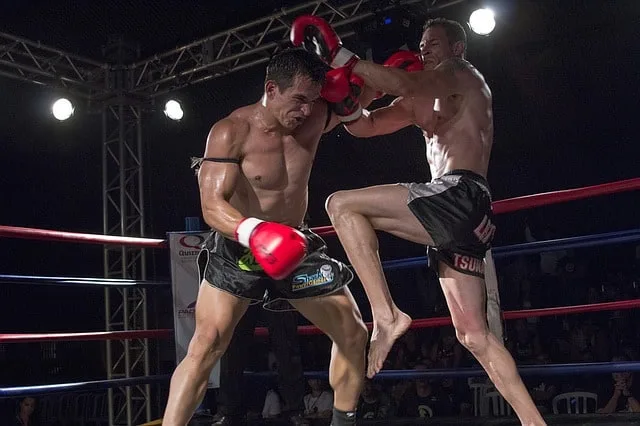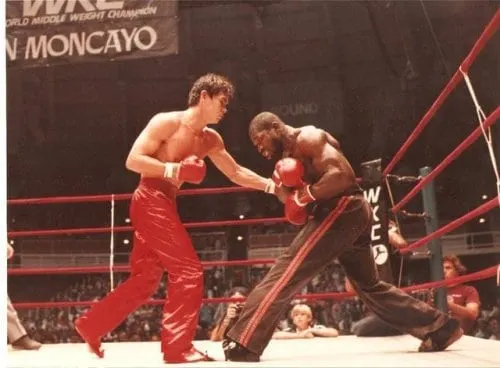
Credit: IKTA European Kickboxing Champion James “The Dragon” Turner provided information about ISKA and IKTA.
If you are a fan of kickboxing or striking martial arts in general, you have likely heard about the term “ISKA Kickboxing.” However, you might not be sure what this ISKA stands for or what role it plays in the world of kickboxing.
ISKA stands for “International Sport Kickboxing Association.” It is a major sanctioning and regulatory body for kickboxing events worldwide and also hosts its own ISKA kickboxing events.
ISKA has sanctioned many well-known events like K-1 and K1 MAX, GLORY Kickboxing, and mixed martial arts (MMA) events like the now-defunct “Strikeforce.” Let’s further explore the history of the ISKA organization, the style it promotes, and how it differs from other governing bodies.
History of ISKA Kickboxing
During the 70s and early 80s, sports karate was very popular in the west and sanctioned by the “Professional Karate Association (PKA).” But the PKA’s influence was declining because of legal and financial problems, while kickboxing’s popularity was growing. Eventually, the PKA sanctioning body was dissolved.
In response to the PKA’s dissolution, resigning PKA executives decided to establish a new governing body, the ISKA (International Sport Karate/Kickboxing Association), on July 16, 1986. The organization was instantly recognized as the major governing body for all sports karate and kickboxing events.
The ISKA continued to sanction full-contact karate/American kickboxing in conjunction with the then-established PKC (Professional Karate Commission). The shows were televised in a seamless continuation from the PKA era, which was later revived as a “promotional” banner but not a “sanctioning body.” I.e., PKA revival shows in the 1990s still had their title fights sanctioned by the ISKA, the IKF (International Kickboxing Federation), and/or the WKA (World Kickboxing Association).
In the meantime, the WAKO organization primarily sanctioned the European market, and the WKA was the main governing body in Asia. However, this didn’t stop ISKA from attempting to spread worldwide. The ISKA strategically split into united organizations such as ISKA Asia, ISKA Australia, and Europe.
In the late 1980s and early 1990s, when Full Contact Kickboxing (wearing long pants and no low kicks allowed) became less prominent, the ISKA became a leading international governing body for both amateur and professional kickboxing events of all rule designations, such as:
- Full-contact
- International Rules (with low kicks)
- Oriental rules (K-1 rules)
- Muay Thai
ISKA has been the world’s leading sanctioning/regulatory body for combat sports and competitive martial arts since 1986. In modern days, though, ISKA is best known worldwide as the International Sport Kickboxing Association, which hosts kickboxing matches and produces some of the greatest kickboxers ever.
RECOMMENDED READING: What Is The History of Kickboxing? – What You Need To Know
ISKA Kickboxing Styles
ISKA has different rule sets and sanctions for different types of kickboxing styles. Following is a list of major styles sanctioned by ISKA in over 50 states worldwide.
K-1 (Oriental Rules)
K-1 is a promotion that emerged from Seidokaikan karate back in 1993. It quickly became one of the world’s most popular combat sports events, even bigger than boxing at some point. ISKA started sanctioning K-1 events in 2000, during the glory days of the promotion, and it has been overseeing the events ever since.
In terms of rules, K-1 is quite simple. Each match lasts 3 rounds, with each round being 3 minutes long. K-1 fighters are allowed to utilize kicks (high and low), punches, and knees in the clinch for a limited amount of time.
K-1 is widely recognized as the most popular and exciting style of kickboxing. Due to the short duration of the matches, the emphasis is on power, high output, damage, and the majority of matches end in vicious knockouts.
Muay Thai
Muay Thai is a national sport in Thailand and one of the most versatile striking systems. Thai boxing events are also sanctioned by ISKA, primarily in Europe and the US. In contrast with other kickboxing styles, Muay Thai includes more techniques and is far more brutal.

Athletes can also fight in the clinch and do damage with vicious elbow and knee strikes, as well as punches and kicks. They can also execute throws and sweeps to take the opponent down, but ground fighting is forbidden.
Most matches include five rounds of action, with each round lasting three minutes. And unlike in other styles, there are 2 minutes of rest between each round, which adds to the excitement of the matches because fighters can exert more energy in the fight and then recover better due to the extended rest between rounds.
American Kickboxing (Full-Contact)
American kickboxing emerged in the 1970s in the US, and it was the first kickboxing style sanctioned by ISKA. This specific variation of kickboxing is unique because it doesn’t include kicks below the waist, also known as low kicks. The focus is on mixing techniques from western boxing with high kicks from karate.

Photo by Don Wilson
In contrast with other styles, American kickboxers wear trousers and shoes. Elbows, knees, clinch fighting, and grappling are strictly forbidden. The matches can last anywhere between 3 and 10 rounds, depending on the importance of the fight, with each round lasting 2 minutes. There is a 1-minute rest period between each round.
Kickboxing Semi-Contact
Semi-Contact is a variation of American kickboxing similar to karate matches. Instead of utilizing full power, the emphasis is on speed and precision. In terms of techniques, the rules are the same as in American kickboxing. Fighters can utilize punches and kicks above the waist only.
They compete wearing a shirt and kickboxing trousers, shin pads, kick boots, and headgear. Matches typically last three rounds, each lasting 2-3 minutes, with a 1-minute break in between rounds. Punches, kicks, and sweeps are awarded 1 point, while kicks to the head bring you 2 points, and jumping kicks to the head bring you 3 points.
Freestyle Rules
This variation is basically American Kickboxing with low kicks. Athletes are enabled to throw punches, high/low kicks, and knees. They compete wearing kickboxing trousers, boxing gloves, mouthguards, shin guards, and groin guards.
The rules allow fighting in the clinch but only for 5 seconds, while throws and sweeps are forbidden. The matches usually include between 3 and 5 rounds for amateurs or up to 10 rounds for professionals. Each round is 3 minutes long, with 1 minute of rest between each round.
Light Contact Kickboxing
Light contact variation is very similar to the full-contact style. It includes the same techniques as full contact, but strikes are thrown with less power, as its name suggests. The focus is on overwhelming the opponent with speed, technique, and precision rather than sheer force.
People also describe it as a competitive sparring session. The rounds are shorter, lasting between 1.5 and 2 minutes, and you can’t win by knockout.
ISKA Kickboxing Rules
ISKA Kickboxing has two codified sets of rules for both amateur and professional competitions. The first is “Unified ISKA/ABC Kickboxing,” while the other is “ISKA Europe Rules.” For the purpose of this article, we will explain the Unified ISKA kickboxing rules.
Match duration — pro kickboxing matches are split into rounds and may have up to 10 rounds. Each round is 3 minutes long, and there is a 1-minute rest period between each round.
Scoring system — each match includes three judges sitting at different sides of the ring. They utilize a 10-point must system to score the match round by round. The winner of the round receives 10 points, while the loser gets 9, 8, or 7, depending on how dominant the winner was. If the round is even, both kickboxers will get 10 points.
Scoring criteria — to determine the winner of the round, judges rely on the following criteria:
- Number of knockdowns
- Cumulative effective impact on the opponent
- Number of clean scoring strikes
- Ring generalship and aggressiveness
Ways to win — kickboxers can win a fight by knockout, decision, or technical knockout by scoring three knockdowns in the same round.
Protective gear — mouthpiece, full-padded boxing gloves, shorts, a groin cup, trousers (American style), and shoes.
Illegal techniques — head butts, groin strikes, strikes to the back of the head or spine, striking on the break or after the bell, holding the opponent, striking the downed opponent.
Legal techniques — punches, low kicks (not in all styles), high kicks, knees (not in all styles), elbows (not in all styles).
ISKA Weight Classes
Following is a detailed explanation of ISKA kickboxing weight classes:
Men’s kickboxing divisions:
| Division | Weight |
| Flyweight | 117lbs; 53.5 kg |
| Bantamweight | 121lbs; 55 kg |
| Featherweight | 125lbs; 57 kg |
| Super-featherweight | 129lbs; 59 kg |
| Lightweight | 134lbs; 61 kg |
| Super-lightweight | 139lbs; 63.5 kg |
| Light-welterweight | 143lbs; 65 kg |
| Welterweight | 147lbs; 67 kg |
| Super-welterweight | 154lbs; 70 kg |
| Light-middleweight | 159lbs; 72.5 kg |
| Middleweight | 165lbs; 75 kg |
| Super-middleweight | 171lbs; 78 kg |
| Light-heavyweight | 179lbs; 81.5 kg |
| Light-cruiserweight | 187lbs; 85 kg |
| Cruiserweight | 194lbs; 88.5 kg |
| Super-cruiserweight | 209lbs; 95 kg |
| Heavyweight | 220lbs; 100 kg |
| Super-heavyweight | +220lbs; + 100 kg |
Women’s kickboxing divisions
| Division | Weight |
| Atomweight | 105lbs; 48 kg |
| Strawweight | 111lbs; 50.5 kg |
| Flyweight | 114lbs; 52 kg |
| Super-flyweight | 117lbs; 53.5 kg |
| Bantamweight | 121lbs; 55 kg |
| Featherweight | 125lbs; 57 kg |
| Super-featherweight | 129lbs; 59 kg |
| Lightweight | 134lbs; 61 kg |
| Super-lightweight | 139lbs; 63.5 kg |
| Light-welterweight | 143lbs; 65 kg |
| Welterweight | 147lbs; 67 kg |
| Super-welterweight | 154lbs; 70 kg |
Are There Any Former ISKA Kickboxers in the UFC/MMA?
Donald Cerrone
Donald Cerrone is a former UFC fighter and one of the greatest who never won the UFC world title. He was primarily known for his advanced kickboxing skills, which he perfectly utilized to win many matches.
Before getting into MMA, Cerrone spent many years competing as a kickboxer, winning many championships across the US. Under the ISKA banner, he won the amateur Colorado State Middleweight Championship.
Stephen Thompson
Stephen “Wonderboy” Thompson is the former UFC welterweight title challenger and one of the most dynamic strikers the world has ever seen. He has a strong background in karate and kickboxing and is one of the few fighters who primarily rely on these two martial arts inside the cage. In his kickboxing career, he became the:
- Southeast Middleweight Amateur champion in 2000
- ISKA Georgia State Middleweight amateur champion in 1999.
Michael “Venom” Page
Although he has never competed in the UFC promotion, Page is among the most popular Bellator MMA fighters. He holds the record for most knockout victories in Bellator history and is a spectacular fighter to watch. Before switching to MMA, Page spent over a decade successfully competing in kickboxing. Among many titles, he also won the ISKA World Martial Arts Championships in 1998.
Who Are the Greatest ISKA Champions?
Throughout history, there have been many great ISKA champions. Following is a list of some of the most accomplished ones.
Jerome Le Banner
Jerome Le Banner is one of the best French kickboxers of all time and the former ISKA World Champion. Known for his massive body frame, big muscles, and aggressive fighting style, Le Banner was among the most feared fighters during the late 90s and the glory days of K-1 promotion.
Although he never won the prestigious K-1 title, he never was in a boring fight, and that’s why so many people still remember him.
Andy Souwer
Andy Souwer is a pure representation of the Dutch style. Inside the ring, Souwer was very aggressive, always pushing forward, attacking with a barrage of high-precision boxing combos, and finishing his attacks with hard low/high kicks.
In his career, he won the K-1 World MAX titles twice (in 2005 & 2007) and became the ISKA World Super Welterweight Champion.
Georgio Petrosyan
Georgio Petrosyan is a kickboxing legend, often considered the most technical kickboxer of all time, which earned him the nickname “The Doctor.” Just the fact that he remained undefeated in K-1 for five straight years, during which he beat the best kickboxers of that era, speaks for itself.
In his career, he won the K-1 World MAX title twice (in 2009 & 2010) and the ISKA World Championship.
Rob Kaman
Rob Kaman is one of the pioneers of modern kickboxing and the Dutch style. Back in the 70s and 80s, Kaman was unstoppable and known for his perfect leg-kicking techniques, which he utilized to perfection.
He finished nine of his opponents with this specific technique. Kaman retired in 1999 with 97 wins on his record (77 knockouts) and just 12 losses. In his career, Kaman won multiple world titles, including the:
- ISKA Oriental Rules Light Heavyweight Champion
- ISKA Full Contact Super Middleweight Champion
Ernesto Hoost
Ernesto Hoost is an absolute kickboxing legend, and many people consider him to be the best K-1 fighter ever. In his career, he won the prestigious K-1 World GP four times and competed at the sport’s highest level for more than two decades.
Inside the ring, he was fast, powerful, and had laser precision, and his fighting IQ was off the charts. This is the main reason why people also describe him as “Mr. Perfect.
Apart from K-1, Hoost also won the:
- ISKA European Championship
- ISKA Muay Thai Championship
Related Questions
What is IKTA?
The IKTA (Intercontinental Kick Thai Boxing Association) was previously known as the IKA (International Kick Boxing Association) but was renamed and newly established as the IKTA in 2012: World President Marco Ghibaudo (Mexico) and Vice World President Massimo Brizi (Italy).
The IKTA fills the void left in the wake of the dissolution/lack of activity of several (Full Contact) Kickboxing sanctioning bodies over the years and revitalizes the sport with a vision of the future. Additionally, the IKTA sanctions all major combat sports: kickboxing, muay thai, K-1 rules, and MMA.
Speaking personally, I can say from experience that the IKTA is like a big family. The athletes who compete regularly in the IKTA are true sportspeople and martial artists.
IKTA European Champion, James “the Dragon” Turner

While it’s lesser known than the ISKA kickboxing association, the IKTA is a platform for highly talented and well-respected martial artists who like to compete in primarily full-contact style against other like-minded martial artists.
RECOMMENDED READING: James "The Dragon" Turner's IKTA endorsed book, "Full Contact Kickboxing: A Complete Guide To Training And Strategies", easily explains kickboxing, combat sports, and the IKTA in greater detail. Disclaimer: This is not a paid endorsement or an affiliate link.
What’s the main difference between ISKA and IKTA?
As can be observed from the organization’s previous name IKA (International Kickboxing Association), the IKTA emphasizes Full Contact Kickboxing as a highly technical and prestigious sport.
The organization’s heritage denotes that this sport (Full Contact) is the “first love” of the association’s leaders. While all combat sports (except Professional Boxing) are featured in IKTA events, Full Contact Kickboxing is prominently featured. Full Contct is often the rule set for ‘main event’ fights on IKTA shows. The ISKA is, of course, one of the original sanctioning bodies for Full Contact rules Kickboxing.
However, a major difference between the ISKA and the IKTA is that while the ISKA still sanction some Full Contact rules fights, their attention has assuredly shifted towards other rule styles, even prominently ‘re-naming’ their Oriental Rules division (with some modifications) to “Unified Rules,” implying that these rules are the “main” Kickboxing rules.
This is so they are in line with organizations such as “GLORY Kickboxing” and “Bellator Kickboxing (sister promotion of Bellator MMA)” and can sanction their title fights, even though this rule system was predominantly known as K-1 rules and was pioneered by the actual K-1 association in many ways.
Conversely, the IKTA more actively promotes Full Contact as its major kickboxing discipline, as that is what the IKTA believes is the most prestigious and spectacular sport/rules style of all. The IKTA also sanctions bouts under what the ISKA calls “Unified Rules,” but the IKTA refers to these as K-1 rules instead.
